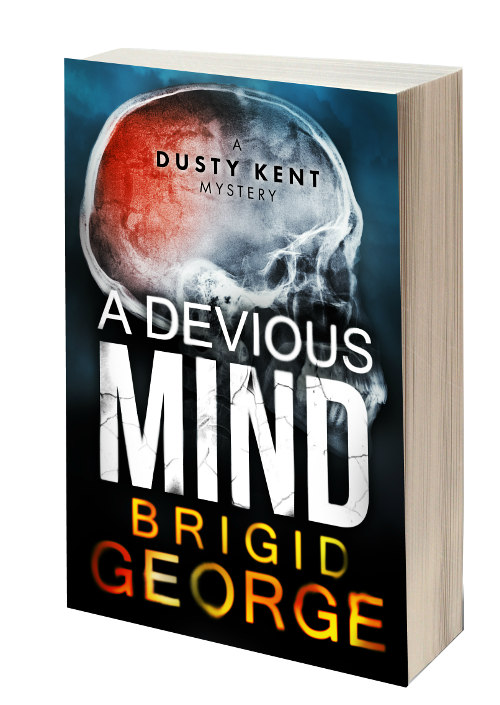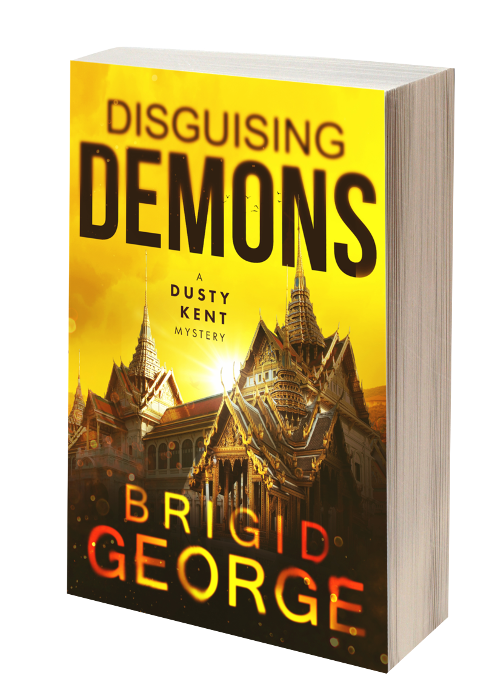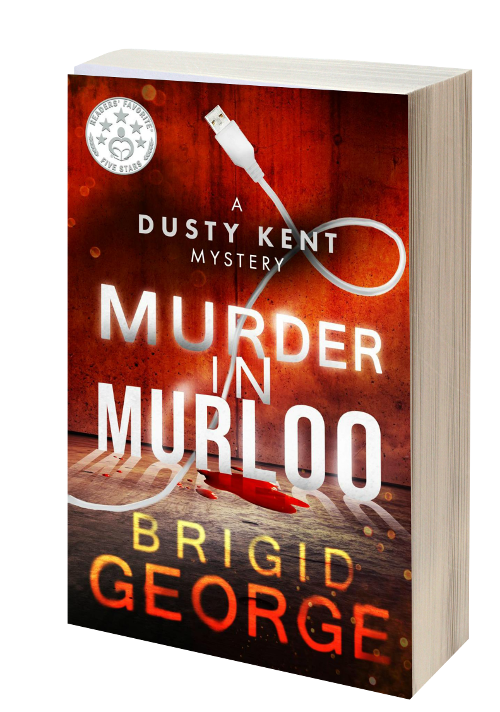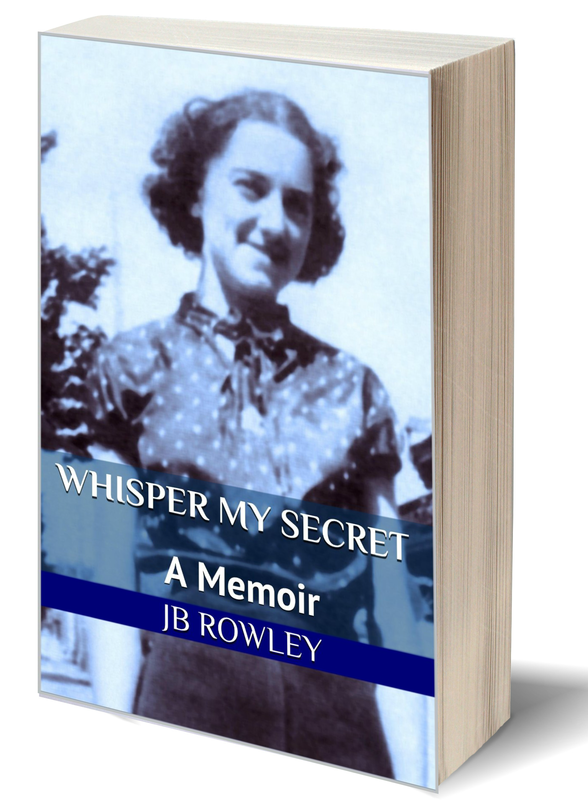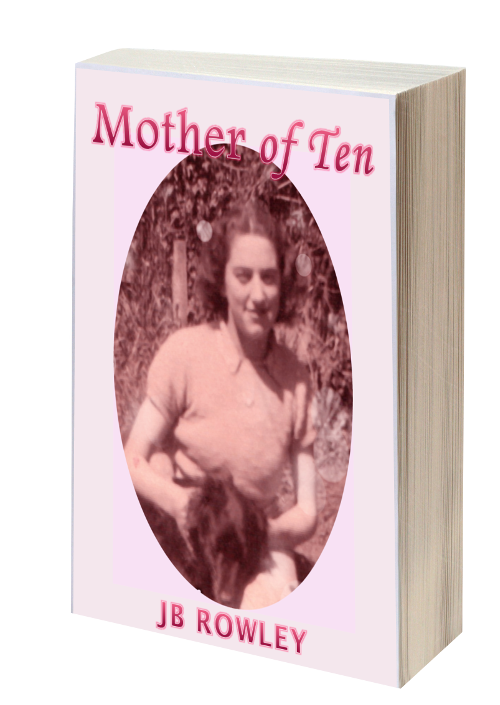|
Yes! Disguising Demons is ready and will be released on October 19th, 2018 but is available now for pre-order. Check it out. This book, #4 in the Dusty Kent series, is set in Port Douglas, in Far North Queensland. It is an idyllic setting visited by the rich and famous from around the world including Bill and Hillary Clinton, George Clooney, Tom Hanks, Glenn Close, Kylie Minogue and many more. See gorgeous photos from my visit to Port Douglas here. Here's the awesome cover designed by Yocla Book Cover Designs. 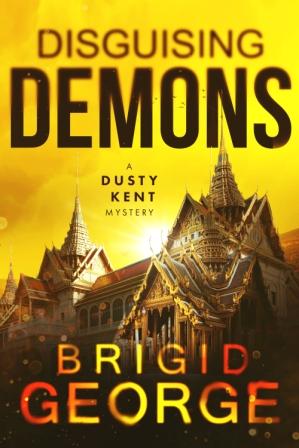 What Dusty discovers in her quest to find the truth about the murder of a gentle Buddhist monk shocks her and and has her Irish assistant questioning whether they should continue with the case. This 4th book in the Dusty Kent Mysteries following Murder in Murloo, A Devious Mind and Rippling Red is certain to captivate you. Let all your cares fall away; read a Dusty Kent today.
0 Comments
The next Dusty Kent mystery is nearing the finish line. In this fourth book in the series, Dusty and her assistant Sean O’Kelly are in Port Douglas, Queensland. Four Mile Beach, Port Douglas early on a warm winter's morning. The manuscript is currently in the UK with Lisanne Radice – renowned crime fiction editor. Changes will need to be made after I receive Lisanne's report; then my awesome beta readers will improve it even further by picking up on any fine details I might have missed. 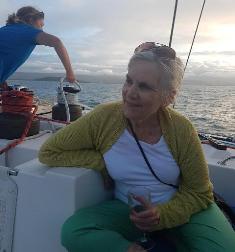 Team Dusty has just returned from our second trip to Port Douglas to research the setting for the book. Not a difficult assignment, escaping Melbourne’s winter to the warmth of Queensland where we enjoyed sunrise walks along the beach, snorkelling among tropical fish on the Great Barrier Reef, early morning swimming in the pool, lazing on the balcony in the green surrounds of the Sheraton Mirage Resort and sailing in a catamaran on the Coral Sea. (See picture above - that's me on the catamaran, supplies in hand. Photo taken by Kay: my unpaid and overworked PA. ) I can’t tell you the title of the book yet, but I can give you a sneak preview of the blurb: 'From an Amazon bestselling author comes a classic whodunit with twists and turns and secrets that must be revealed... The dead body of a Buddhist monk is found at the bottom of a cliff early one morning. Four months later with the killer still at large, the police in the small town of Port Douglas in Australia’s Far North Queensland call in Dusty Kent: investigative journalist renowned for her ability to solve cold cases. Dusty’s heart goes out to the humble monk who lived quietly in a forest community, nurturing the garden and volunteering to read books to elderly residents. Why would anyone want to kill such a gentle soul? Is the killer a fellow monk with psychopathic traits? Had small town prejudice against the forest community manifested into violent hatred? What Dusty discovers in her quest to find the truth shocks and saddens her and has her Irish assistant questioning whether they should continue with the case.' LET ALL YOUR CARES FAll AWAY; READ A DUSTY KENT TODAY! Murder in Murloo, A Devious Mind, Rippling Red. Until next time. JB (aka Brigid George) For a free gift from Brigid George CLICK HERE! Team Dusty enjoying pre-dinner drinks on our last evening in Port Douglas
at Nautilus Restaurant deep in a rainforest. Photo taken by our waiter, Etienne. Sometimes readers think the Dusty Kent Murder Mysteries need to be read in sequential order like a serial (a story that is published in several parts over a period of time). That is not the case. The Dusty Kent Murder Mysteries are a series (several books that deal with the same subject or feature the same character) much like Agatha Christie’s Poirot series. Each Dusty Kent book is a stand-alone story. The books can be read in any order and you don’t need to read all the books if you don’t wish to. (I hope you do!)
The other confusing issue is genre. On Amazon.com the Dusty Kent series is listed in the 'Mystery, Thriller and Suspense' category. Wow! That is so broad and potentially misleading for readers. For those of us who are particular about the type of crime novel we want to read, choosing a book from such a wide range of styles can be time consuming. I don’t want to read thrillers or suspense. I want a jolly good murder mystery. BUT under the sub heading of Mystery you could find: police procedurals, murder mysteries, mysteries that do not involve murder, cosy murder mysteries, whodunits and goodness knows what else. Choosing the one that is just right is not quick and not always easy. The Dusty Kent books, such as Murder in Murloo, are not thrillers or suspense. Murder in Murloo is a murder mystery. But what sort? Easy! A whodunit. Once I would have called Murder in Murloo a cosy/cozy mystery. However, cosy murder mysteries are now often associated with the very light, often humorous, style of detective fiction. They are like pavlovas: light and sweet and devoured easily and quickly, leaving the reader smiling and licking their lips. A whodunit, on the other hand, is more like a fruit cake: light enough to rise in the oven but with a substantial filling that can be savoured with leisurely deliberation. Sometimes the filling has a few nuts and sometimes even a little alcohol, but the ‘cake’ is essentially wholesome. I hope that helps you decide whether a Dusty Kent Murder Mystery is the sort of book you would like to read. I hope the answer is yes because as Lawrence Wargrave said in Agatha Christie’s And Then There Were None: ‘...no artist, I now realize, can be satisfied with art alone. There is a natural craving for recognition which cannot be gainsaid.’ JB (writing as Brigid George) Rippling Red, Dusty Kent Murder Mystery #3 set in Darwin was released in April 2017. And now #4 is on target to be released later this year. I enjoyed a blissful two months over December and January working on the book without any teaching commitments (I tutor English students). It makes such a difference to the flow of writing to be able to spend a good amount of time on a daily basis working on a manuscript. The first rough draft is done; I know who was murdered and I know ‘whodunit’ – but I’m not telling you! I’m excited about this book; it has shaped up well with twists and turns, eccentric characters, broken hearts and (of course) a murderer trying to outsmart Dusty Kent. The book doesn’t have a final title yet. I’ve tested a few out but haven’t found the one that is ‘just right’. That’s pretty much a normal process for me. Often I’ll end up choosing the very first title I tried out – it just didn’t feel right until I’d tried a few others as well. Quirky, right? Anyway, Dusty Kent and her research assistant Sean O’Kelly are investigating a cold case murder in Port Douglas, in Australia’s tropical North Queensland. When I went to Port Douglas last year with two of the Dusty Kent team members we liked it so much we decided we’d go back and that’s what we’re doing in July this year. We’ll have a few warm days away from Melbourne’s cold winter – the only thing I don’t like about Melbourne. Murder in Murloo, the first Dusty Kent Murder Mystery, has been selling well, followed closely by the second in the series, A Devious Mind. Thanks so much to those of you who have read, recommended or reviewed the books. I’m looking forward to finishing and releasing #4 for your enjoyment. Until next time...JB (aka Brigid George) For a free gift from Brigid George CLICK HERE!
A reader who kindly reviewed A Devious Mind noted that the Dusty Kent murder mysteries take place in a different location each time and commented, ‘I'd like to find a good map to learn about the different areas of Australia where the murders take place.’ So I’ve put together a simple map (see below) showing the location of each murder. No jokes about my terrible mapping skills, please. :) When I have more time and courage I might create an interactive map but for the time being I hope the simple one will suffice. The location of the Dusty Kent Murder Mysteries are in blue font. Murder in Murloo (Dusty Kent Mystery #1) takes place in the state of Victoria in a fictional coastal village called Murloo inspired by the township of Marlo in East Gippsland. Marlo, where the famous Snowy River meets the Southern Ocean, is a small community that attracts visitors to its unspoilt beaches, natural waterways and abundant wildlife. Conscious that small towns often consider it bad publicity to host a fictional murder, I changed Marlo to Murloo (the Aboriginal word for the Marlo area). A Devious Mind (#2) is set in Byron Bay, New South Wales. This is also a small town but larger than Marlo. In this instance I created a fictional suburb for the setting of the murder instead of changing the name of the town. Rippling Red (#3) is set in Darwin, the capital city of the Northern Territory. Although cities like Darwin cannot claim to be ‘murder free’ and therefore would not have the same sensitivity to hosting a fictional murder, I have created an imaginary place in Darwin for the setting of the murder. Disguising Demons (#4) is set in Port Douglas, Queensland. Once again I have retained the name but created a fictitious place for the setting of the murder. For Dusty Kent Mystery #5, we are heading to Broome, Western Australia - not marked on the map yet. UPDATE 19 December 2020: Broome is now marked on the map. For a free gift from Brigid George CLICK HERE!
It’s July 2017. A trio of women almost frozen stiff by Melbourne’s wintry chill fly north to Port Douglas in Queensland where we are warmly greeted with a heavenly 27 degrees Celsius. The area being tropical they get plenty of water and they had just had five days of rain before we arrived and on the day we left the forecast was for another five days of rain. But during our short stay we were blessed with sunny days and balmy evenings. On our first stroll through the town I knew immediately it was the perfect setting for the fourth Dusty Kent Murder Mystery planned for release at the end of 2018. Port Douglas is a village with one main street, lots of cafes and several pubs - of course. One of the pubs features a wall mural depicting all the pub’s drinkers painted in the 1980s by Strom Gould, one of the many eccentric local identities of the time. Yep, Port Douglas is the perfect place for a murder! A fictional murder, that is. It was difficult to imagine a real murder taking place in this friendly, laid-back town populated with little over 3000 people. But I discovered a real murder had been committed in Port (as the locals like to call it) and the perpetrators had been hanged. One of the convicted murderers was 42-year-old Ellen Thomson. In 1887, only ten years after Port Douglas had been named, Ellen and her alleged lover, 27-year-old John Harrison, were convicted of killing Billy Thompson, Ellen’s physically violent and verbally abusive husband. To be precise, John Harrison was convicted of killing Billy Thomson. Ellen was convicted of ‘aiding and abetting’ Harrison, not murder. But they hanged her just the same. On the eve of his execution, Harrison confessed to being solely responsible for the murder but despite that admission being reported to the Under-Sheriff, Ellen was not spared. “It’s too late,” they said. Even as she stepped up to the drop, Ellen maintained her innocence, forgave those who had wronged her and asked that her children be taken care of. This uneducated mother of five whose family brought her to Australia at the age of eleven from Ireland is the only woman ever sent to the gallows in Queensland. Heartbreaking. One hundred years later another potential murder victim, perhaps an even more deserving target than Billy Thomson, arrived in Port Douglas. Not that anyone in Port would wish Christopher Skase harm, but plenty of Australians and the Australian government were out for his blood. Skase, a millionaire entrepreneur from Melbourne who stole millions of dollars from shareholders, saw Port Douglas as an opportunity waiting to be milked. Eventually, this white-collar criminal became Australia’s most wanted fugitive when he fled to Spain to escape prosecution and to hide the stolen money. A real oily snake! For Port Douglas residents, however, Skase was the knight in shining armour who put the town on the tourist map in 1988 when he built the Port Douglas Sheraton Mirage, a five star luxury resort backing onto Four Mile Beach. Port Douglas people remain grateful to Skase to this day but acknowledge his use of stolen money. In a publication called Port’s People, John Morris ‘who is sometimes known as the king or father of Port Douglas’ admits, “...we’ve got to thank the share holders that put up the dough to develop it...”. Although my friends and I didn’t stay at the Sheraton Mirage, we did enjoy lovely long walks along Four Mile Beach. One of our party, who grew up in Goa, India was transported to ‘nostalgia lane’ when she saw the beach was fringed with coconut palms abundant with fruit. (See picture of Four Mile Beach above.) At the north end of the beach is the start of the not-too-steep climb to Flagstaff Lookout Hill. Spectacular views reward you when you reach the top. Apart from leisurely discovering Port Douglas and trying as many eating places as we could, we also spent a memorable day on a tour of the Daintree Rainforest with Tony’s Tropical Tours. Port Douglas is the only place on Earth where two World Heritage Listed sites meet: the Great Barrier Reef and the Daintree Rainforest. The rainforests we walked through were so lush and fertile we almost had to fight our way through the vines and palm fronds. Included in our tour was an outdoor lunch and walking expedition in Noah Valley, a World Heritage Listed private property. I judged the pristine clear waters in Noah Valley to be a smidge too cold to swim in, but one brave Norwegian from our tour group couldn’t wait to strip down to his bathers and jump in. He enjoyed it so much we almost had to leave him behind. Our last evening in Port Douglas (when we dined on exquisite Italian food at Bel Cibo) arrived way too soon. Claudette (in the butterfly shirt), Kay and JB (in pink) drinking cocktails at Bel Cibo. Reluctant to leave, we thought perhaps we would need to come back and do a little more research on this particular book setting. The first two photos in this blog taken by Claudette. The last one was taken by our helpful waitress at Bel Cibo. For a free gift from Brigid George CLICK HERE!
In July 2016, Melbourne was in the grip of icy cold winter weather when, accompanied by my good friend and unpaid personal assistant Kay Wee, I headed off to Darwin to research the setting for Dusty Kent Murder Mystery #3. Darwin winter is a completely different kettle of fish to Melbourne winter. In Darwin it’s balmy in the morning, balmy in the evening, balmy at dinner time. And the residents are sometimes barmy − or was that a tourist I saw with a crocodile cap on his head, its huge jaws peaking over his face? Darwin is the capital city of Northern Territory, colloquially known as the Top End. Northern Territory is one of the most lightly populated places on Earth and that means its capital offers the advantages of a city without the traffic congestion and the hoards of people. The Top End is also a place where you grow up tough and the blokes believe that: You’ve got to get off your arse and do some hard yakka. The Aboriginal people of the Larrakia language group who had trading routes with Southeast Asia were the first people to make the Darwin area home. Many years later, in 1869, the South Australian Government established a small European settlement at what was then called Port Darwin. The settlement grew into a thriving township but suffered a devastating setback in 1942 when Japanese warplanes bombed the town causing immense damage and killing 243 people. Tragedy visited again in 1974 when Darwin, now officially a city, was struck by Cyclone Tracy and the city was almost totally destroyed. However, the Darwin that Kay and I visited is a modern nurtured city of wide open spaces that exudes a slow, relaxed feel. Public areas are cleaned daily and the lawns and gardens are maintained impeccably. Our first priority on arrival in Darwin was to locate points of interest for Dusty and Sean. We found pool tables at Hotel Darwin for Sean and discovered he would be able to enjoy a Guinness on tap at Shenannigans or at Fiddlers Green where a sign says: No working during drinking hours. Fiddlers Green is located on the waterfront, a vibrant precinct where, among other things, people swim in the lagoons safe from crocodiles, picnic on the lawns, meet friends for coffee or dine on delicious seafood. In Bicentennial Park we were embraced by warm breezes and shaded by the capacious canopies of tropical trees: the perfect place to enjoy our daily walks. Built on the porcelanite cliffs that overlook the 1000 square kilometres of Darwin Harbour, Bicentennial Park also offers stunning views. I was fascinated to learn that the Harbour was formed by the drowning of several major river systems after the Ice Age when melting glaciers caused sea levels to rise. Having settled the needs of the book’s main characters, Kay and I decided to have some fun ourselves. We enjoyed good food and the occasional martini at SkyCity, (see picture below)
In A Devious Mind, Dusty and Sean have teamed up again to work on another unsolved murder following their success in Murder in Murloo. This time they are lucky enough to be in Byron Bay, Australia’s famous alternative lifestyle beach town. The town’s welcome sign tells you all you need to know. It reads: Cheer Up, Slow Down, Chill Out...
Apart from the laid-back, low-key lifestyle, the Byron Bay area is renowned for its biological diversity, supporting a wide range of frogs, snakes, marsupials, birds and plants. Its natural beauty includes spectacular beaches, world heritage rainforests, waterfalls, conservation parks and abundant marine life such as whales and dolphins. I was lucky enough to go to Byron Bay too because, of course, I had to research the setting for the book. So, on Anzac weekend in 2015, I dragged some friends along for a short holiday at Ardem@Byron. Actually, dragged is the wrong word because they certainly weren’t protesting. After all, we were exchanging the chilly cold of Melbourne for the balmy warmth of Byron Bay. On Anzac Day, we attended the Dawn Service in Byron where I met a young man who had previously made the trip to Gallipoli to pay homage to the thousands of young men who fought in the trenches in 1915. I was moved by his description of the trip and how after seeing the landscape for himself he developed empathy for the soldiers of the past. Later that day we had a little fun and lost a little money in the traditional Anzac game of Two-up. The rest of our stay was spent exploring Byron and meeting the locals, including Daniel Green who ended up in A Devious Mind. Well, to be more accurate, his name did. He kindly offered me his name for a character when I met him at the pool table in the Beach Hotel. We also dined on fine food at a variety of Byron’s excellent eating places. We cruised the shops, from boutiques, to stores with a difference, to markets showcasing local artisans and crafts people and local produce. And we walked. One of our beautiful walks took us to Cape Byron Lighthouse. On the way we passed through Wategos Beach where bottlenose dolphins love to surf. Another species of surfer swarms to Wategos in Kombi vans which are parked in a seamless line along the beach front against a backdrop of rows of multi-million dollar houses. On our last morning we ventured out at the crack of dawn again – to experience the sunrise atTallow Beach. That was the day I had to drag my friends back to Melbourne. This time they were protesting! JB aka Brigid George
For your free gift from Brigid George CLICK HERE!
In the summer of 2014 I was visiting Marlo (Victoria, Australia) soaking up the atmosphere while I put the finishing touches to Murder in Murloo. Another visitor to the area at the same time was Miss Ellie, a fat elephant seal. Miss Ellie visits each year to moult her skin before journeying back to the sub-Antarctic. On this occasion she not only made her way into the Snowy River Estuary but also into my manuscript. It’s not hard to see why Miss Ellie and hundreds of human visitors love to spend time at the unspoilt beaches and natural waterways of Marlo where the famous Snowy River meets the Southern Ocean. It’s a place that has inspired many writers over the years and was my inspiration for the fictional town of Murloo. The name of my fictional town is the Aboriginal word for the Marlo area. (Murloo is possibly a corruption of Murraloo). The Aboriginal tribal group which has lived in the area for at least 18 000 years is the Gunai (sometimes spelt Kurnai). The Dreamtime ancestors of the Gunai people, Borun the pelican and Tuk, the musk duck, still inhabit Marlo. In fact, the environment in the area of Marlo remains so natural that wildlife is abundant. Playful seal pups can sometimes be seen frolicking near the jetty, closely observed by pelicans that swoop overhead and perch on tall posts. The calls of other birds, such as kookaburras, magpies, rosellas and whipbirds mingle with the sound of the surf as you stroll through the coastal rainforest. I was walking along one of the bush tracks when I spotted a male lyrebird close enough to the track for me to observe him. Seeing a lyrebird in the wild is a rare joy, even for someone like me who roamed the bush every day as a child (we lived several kilometres out of town) and did not catch a glimpse of one. The next day, two female lyrebirds walked right cross the track in front of me. One of these lyrebirds even sang me a pretty song. Unlike Miss Ellie, the lyrebird with its magnificent tail did not make his way into the book – not this one anyway. Murloo Mansion, the luxury hotel in Murder in Murloo is situated on the bluff where a bark hut was built in 1875. The bark hut eventually evolved into a hotel, but in my imagination it evolved much further into a magnificent heritage hotel reminiscent of the Australian Gold Rush Era. A ten minute drive from Marlo is the township of Orbost where I was born and grew up. My hometown is the inspiration for the town in Murder in Murloo called Claigan. Since Orbost was named after a place on the Isle of Skye in Scotland, I decided to name my fictional town in the same way. Claigan is situated in north western Isle of Skye. By the way, unlike Murloo, Marlo has never, to my knowledge, been host to a murder. Until next time... JB & BG For your free gift from Brigid George CLICK HERE!
|
AuthorBrigid George is the pen name for JB Rowley. Brigid George writes murder mysteries like Murder in Murloo. JB Rowley writes other books like Whisper My Secret. Archives
December 2023
Categories
All
|
- Brigid George, Author
- Free Booklet
- Brigid's Books: Murder in Murloo
- Brigid's Books: A Devious Mind
- Brigid's Books: Rippling Red
- Brigid's Books: Disguising Demons
- Brigid's Books: Tooting Moon
- Brigids Books: Murder on a Melbourne Tram
- Brigid's Books: Death in The Dandenongs
- Dusty Kent: Cold Case Warrior
- FREE Short Story
- Brigid's Blog
- Love to hear from you
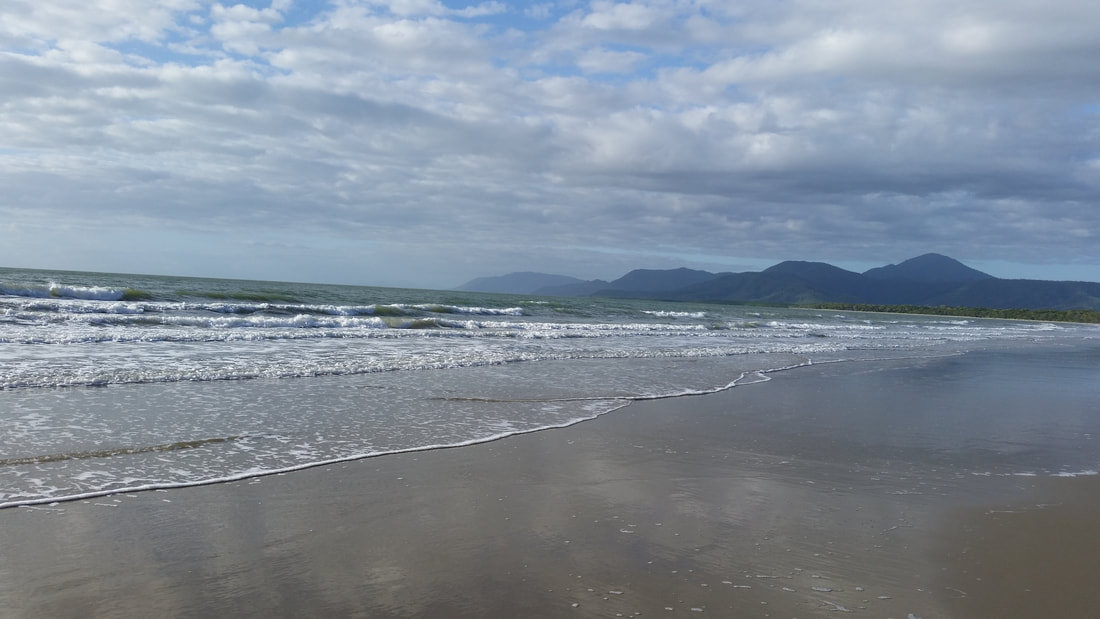
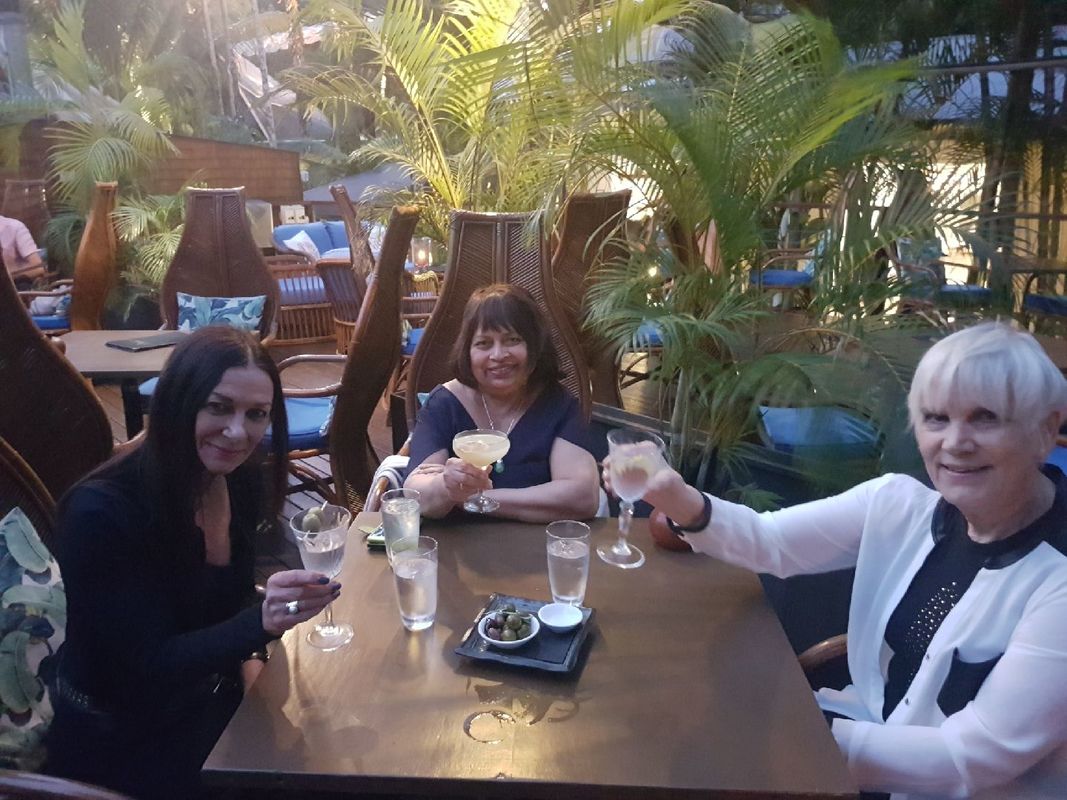
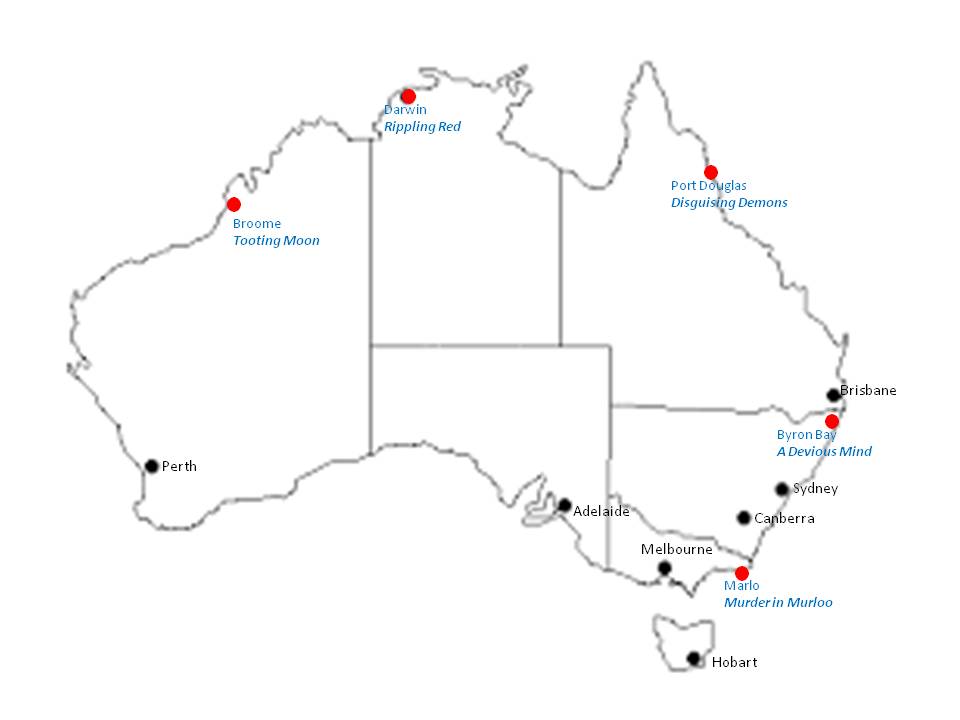
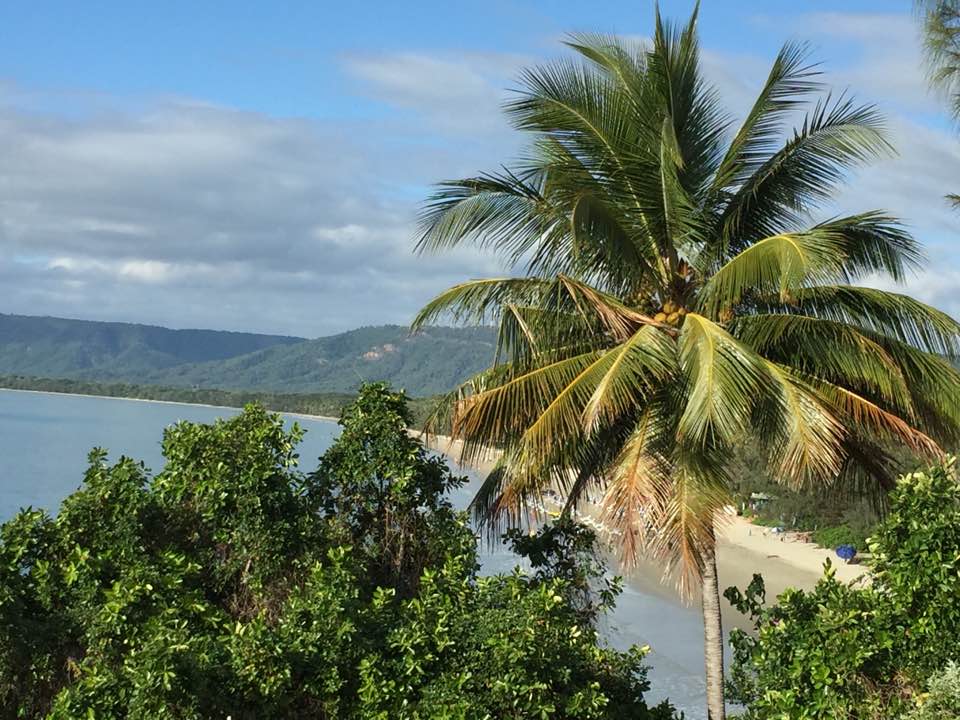
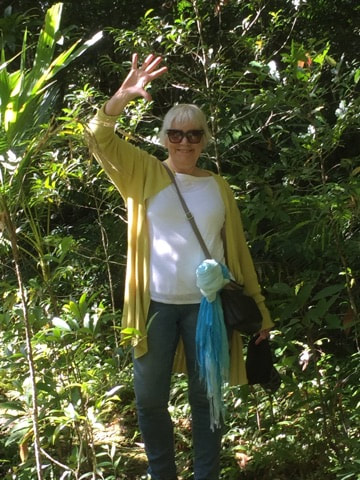
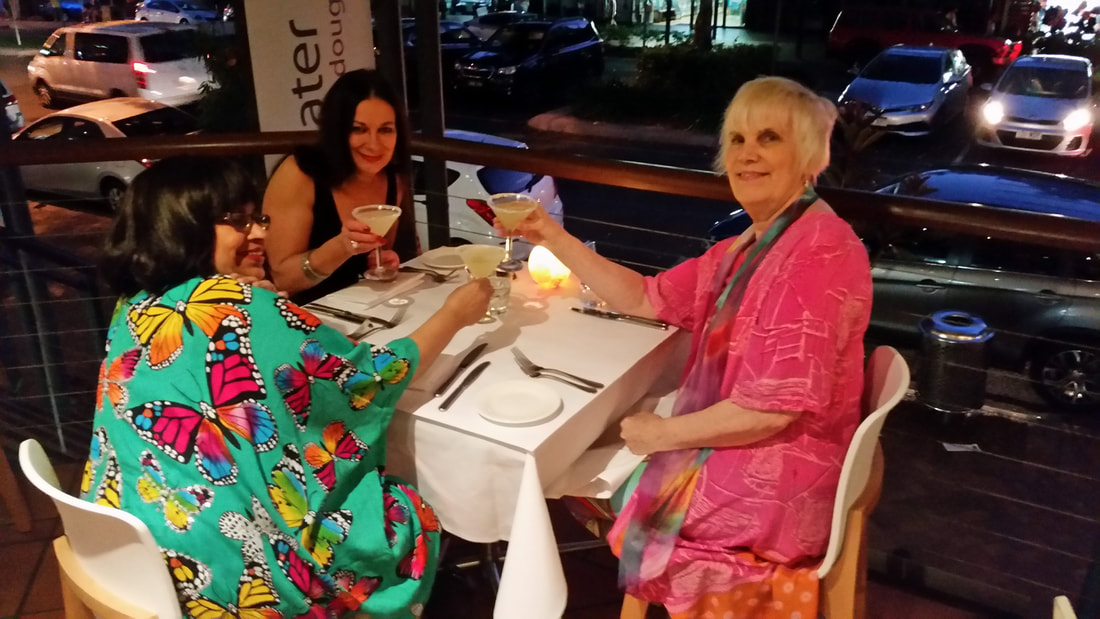
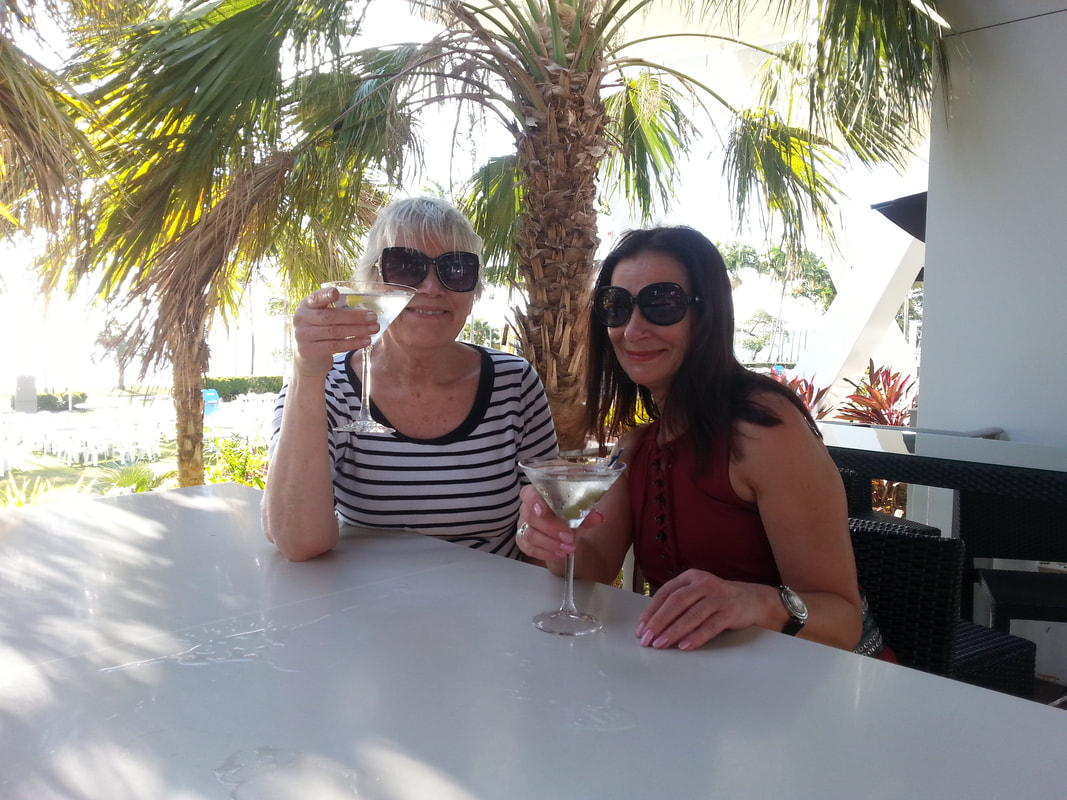
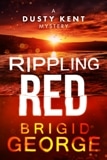
 RSS Feed
RSS Feed
